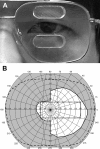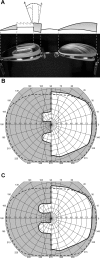High-Power Prismatic Devices for Oblique Peripheral Prisms
- PMID: 26866438
- PMCID: PMC4840069
- DOI: 10.1097/OPX.0000000000000820
High-Power Prismatic Devices for Oblique Peripheral Prisms
Abstract
Purpose: Horizontal peripheral prisms for hemianopia provide field expansion above and below the horizontal meridian; however, there is a vertical gap leaving the central area (important for driving) without expansion. In the oblique design, tilting the bases of both prism segments toward the horizontal meridian moves the field expansion area vertically and centrally (closing the central gap) while the prisms remain in the peripheral location. However, tilting the prisms results also in a reduction of the lateral field expansion. Higher prism powers are needed to counter this effect.
Methods: We developed, implemented, and tested a series of designs aimed at increasing the prism power to reduce the central gap while maintaining wide lateral expansion. The designs included inserting the peripheral prisms into carrier lenses that included yoked prism in the opposite direction, combination of two Fresnel segments attached at the base and angled to each other (bi-part prisms), and creating Fresnel prism-like segments from nonparallel periscopic mirror pairs (reflective prisms).
Results: A modest increase in lateral power was achieved with yoked-prism carriers. Bi-part combination of 36Δ Fresnel segments provided high power with some reduction in image quality. Fresnel reflective prism segments have potential for high power with superior optical quality but may be limited in field extent or by interruptions of the expanded field. Extended apical scotomas, even with unilateral fitting, may limit the utility of very high power prisms. The high-power bi-part and reflective prisms enable a wider effective eye scanning range (more than 15 degrees) into the blind hemifield.
Conclusions: Conventional prisms of powers higher than the available 57Δ are limited by the binocular impact of a wider apical scotoma and a reduced effective eye scanning range to the blind side. The various designs that we developed may overcome these limitations and find use in various other field expansion applications.
Figures













References
-
- Peli E. Field expansion for homonymous hemianopia by optically-induced peripheral exotropia. Optom Vis Sci 2000; 77: 453– 64. - PubMed
-
- Vargas-Martin F, Garcia-Perez MA. Visual fields at the wheel. Optom Vis Sci 2005; 82: 675– 81. - PubMed
-
- Cohen JM, Waiss B. Visual field remediation. In: Cole RG, Rosenthal BP, eds. Remediation and Management of Low Vision. St. Louis, MO: Mosby; 1996; 1– 25.
MeSH terms
Grants and funding
LinkOut - more resources
Full Text Sources
Other Literature Sources
Medical
Miscellaneous

